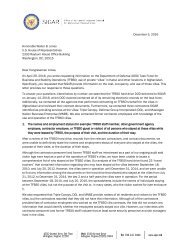SIGAR
2016-04-30qr
2016-04-30qr
You also want an ePaper? Increase the reach of your titles
YUMPU automatically turns print PDFs into web optimized ePapers that Google loves.
Security: The eroding bedrock<br />
Afghan Air Force. Due to poor planning, poor oversight, poor contract management,<br />
and a lack of critical spare parts, those aircraft could not be kept<br />
flightworthy. The program was ended in March 2013 after experiencing continuous<br />
and severe operational difficulties, including a lack of spare parts.<br />
Sixteen of those 20 aircraft were sold for scrap metal for six cents a pound<br />
or $32,000. 50<br />
Ensuring that the ANDSF will be a sustainable security force—including<br />
appropriate enablers and advisors—will require considerable improvements<br />
and constant attention in funding, recruiting and retention, materiel and<br />
supply procurements, training and maintenance, and program management.<br />
That will be a heavy lift.<br />
Force Misuse And Enemy Reaction<br />
Complicate The Picture<br />
The ANDSF has fought hard over the past year, and DOD says it has continued<br />
to improve integration of indirect-fire and close-air attack capabilities.<br />
But its performance has been uneven, with numerous, high-profile tactical<br />
and operational setbacks detracting from overall success in preventing<br />
the Taliban from achieving strategic goals. And capability gaps persist<br />
in aviation, intelligence, logistics, maintenance, operational planning,<br />
and leadership. 51<br />
Even if ANDSF capability gaps were filled and performance made<br />
more consistent, however, two variables remain: how well the force is<br />
employed, and how its adversaries adjust to the changing calculus of<br />
comparative advantages.<br />
The ANDSF, according to DOD’s latest semiannual report to Congress,<br />
remains “reactive,” allowing insurgents to pick and choose targets on their<br />
terms. 52 “Though checkpoints and a fixed ANDSF presence, rather than<br />
patrols or a rotational presence, is consistent with Afghan perceptions of<br />
security—especially in rural areas—the ANDSF reliance on defending static<br />
checkpoints has come at a cost of increased ANDSF casualties,” DOD says.<br />
Consequently, “the ANDSF are being out-maneuvered by an overall numerically-inferior<br />
insurgent force. Furthermore, broadly emplaced checkpoints<br />
compound existing logistics and supply challenges.” 53 In addition, overrunning<br />
small outposts can allow insurgents not only to inflict casualties,<br />
demoralize ANDSF units, discourage potential recruits, and undermine government<br />
control, but also to capture equipment, ammunition, and uniforms<br />
to use in other operations.<br />
Another aspect of questionable use of ANDSF personnel, according to<br />
DOD, is that Afghan National Police members “are often . . . misemployed<br />
as personal bodyguards.” 54 <strong>SIGAR</strong> has also heard of Afghan special-forces<br />
personnel assigned to defensive posts, and of trained medical personnel<br />
assigned to non-medical positions. Meanwhile, despite the ANDSF’s<br />
14<br />
Special inspector general I Afghanistan reconstruction




